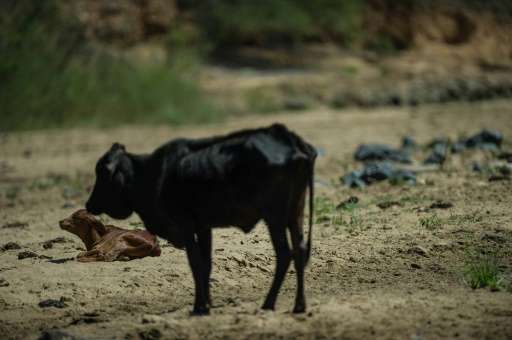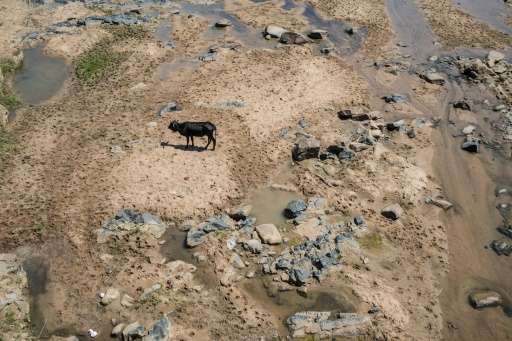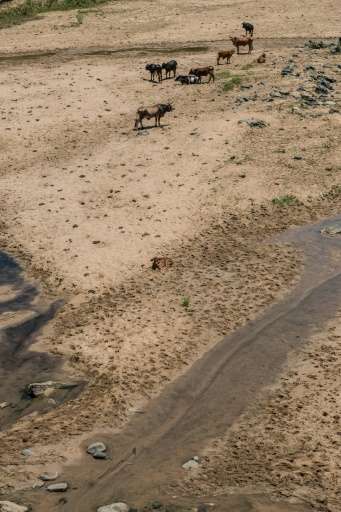Cattle dying in South Africa as drought deepens

In the middle of a desiccated lake bed in South Africa's North West province, a seven-month-old calf is too weak to get up. It is doomed to die from thirst and hunger.
A devastating drought is claiming thousands of livestock in Africa's most developed economy and prompting many to fear famine.
A few kilometres (miles) away in the district of Madikwe, 30 villagers join Josephine Motsoasele, a traditional healer leading prayers for rain.
In a trance-like manner, farmers and villagers draped in colourful traditional cloths and sing and pray in local vernacular Setswana for the heavens to open up.
"God, give us rain because we have a big problem," Motsoasele prays, fearing widespread starvation. "We can't do anything."
It is not yet noon, but the room temperature has already breached 40 degrees Celsius (104 degrees Fahrenheit).
The drought, blamed on the global cyclical extreme weather system El Nino, is the country's worst since 1982.
Located near the border with Botswana, the man-made Molatedi dam is the largest in the province of 3.7 million people. It is now only five percent full.
On the cracked earth, hundreds of cattle wander in search of the last drinking hole or that rare blade of grass.
A drying carcass of a cow lies on the parched ground, carved up by vultures.
According to meat producers, tens of thousands of cattle have died or are being culled due to the drought.
"There's lots of animals dying on the farms," said Lardus van Zyl, chairman of the Red Meat Producers Organisation.

Farmers are now auctioning their stocks before they die on their own and nearly a third more animals are being butchered compared to the same time last year, "mainly because of the drought," van Zyl told AFP.
"In my experience it's worse than ever, in the past at least the cattle was surviving," said rancher McDonald Modise eyeing a carcass of one of his cows, which had died the previous day.
He will cook it for his dogs because it is no longer fit for human consumption.
'People are going to die'
Farmer Molemi Modise wrings a handful of dry grass. "It's so bad when it's get dry like this, even if the cattle feeds from this, it's useless."
"If we don't get rain now I can assure you our people are going to die."
Further south in the same province grain producers are also reeling and looking up to the skies, hoping for a miracle.
"If it was normal, I was supposed to be planting maize, but now I can't do nothing," maize farmer Rykie Raphoto said standing in his empty field.
"There will be no food for the nation," he said.

The impact of the drought is massive for South Africa, the region's breadbasket, but could be dire for the rest of the countries in southern African region that traditionally import from it.
Agriculture Minister Senzeni Zokwana warns of a "regional disaster" if the drought persists.
"We have seen cattle dying, we have seen plants withering, we don't want to see people dying," he said.
South Africa this year produced roughly eight million tonnes of maize, also called corn, but in a good season harvests can reach 14 million tonnes.
"We're looking at a scenario where we'll have to import," said Arno Van Vuuren, a senior official of the farmers' association in the North West.
Prices of maize are going up, according to farmers and government.
Five of the country's nine provinces have already been declared disaster areas and government has allocated 220 million rand ($15 million, 14.2 million euros) to help farmers buy animal feedstuffs.
Weather experts forecast that rains could fall in March next year.
Sparked by a warming in sea surface temperatures in the equatorial Pacific, El Nino wreaks havoc on world weather patterns periodically, causing exceptional drought in some parts and floods in others.
© 2015 AFP




















